Ornithoteuthis antillarum
Michael Vecchione and Richard E. YoungIntroduction
Ornithoteuthis antillarum is known from the Atlantic Oceans. It appears to be a smaller species than its Pacific and Indian Ocean congener, O. volatilis, reaching 141 mm ML.
Characteristics
- Arms
- Right arm IV hectocotylized.
- Nine large basal suckers followed by 14 smaller suckers beyond which no suckers exist, only a few pedicels; distal third of arm with large flattened, triangular pedicels folded over onto the ventral border (Voss, 1957).
- Midventral surface with honeycomb-like sculpturing with 4-5 longitudinal columns of depressions, 20-25 depressions in each column (Dunning, 1998).
- Nine large basal suckers followed by 14 smaller suckers beyond which no suckers exist, only a few pedicels; distal third of arm with large flattened, triangular pedicels folded over onto the ventral border (Voss, 1957).
- Sucker dentition sexually dimorphic on all arms (Voss, 1957).
- Female with about 8 plate-like teeth proximally with teeth becoming more numerous and pointed in mid-arm.
- Male with large lateral plates in mid-arm.
- Proximal arms II suckers with different dentition between dorsal and ventral series (Voss, 1957).
- Dorsal series: Suckers 1-6 with single, large, pointed tooth distally with 1 or 2 small, plate-like teeth on each side.
- Ventral series: Suckers 1-5 with 2 small, medial teeth distally, with 2 small, plate-like teeth on each side.
 Click on an image to view larger version & data in a new window
Click on an image to view larger version & data in a new window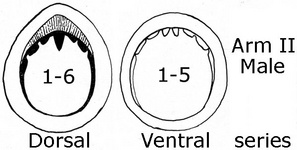
Figure. Oral views of proximal 5 or 6 suckers of arms II from male O. antillarum showing different dentition between dorsal and ventral sucker series. Drawings modified from Voss (1957, p. 372, Fig. 1h,g).
 Click on an image to view larger version & data in a new window
Click on an image to view larger version & data in a new window
Figure. Medial-side view (top) and oral view (bottom of the hectocotylus of O. antillarum. Drawing from Voss (1957, p. 375. Fig. 2b, c).
- Right arm IV hectocotylized.
- Tentacles (Voss, 1957)
- Sucker-bearing region of club about half tentacle length.
- Large manus suckers with about 18-20 sharp, round, curved teeth widely separated from one another.
- Dactylus suckers largest in ventral series, decreasing in size to dorsal series.
 Click on an image to view larger version & data in a new window
Click on an image to view larger version & data in a new window
Figure. Oral view of the tentacular club of O. antillarum. Drawing from Voss (1957, p. 375, Fig. 2d).
 Click on an image to view larger version & data in a new window
Click on an image to view larger version & data in a new window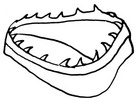
Figure. Side-oblique view of a large club sucker ring of O. antillarum. Drawing from Voss (1957, p. 375, Fig. 2i).
- Head
- Beaks: Descriptions can be found here: Lower beak; upper beak.
- Beaks: Descriptions can be found here: Lower beak; upper beak.
- Funnel
- Folds in foveola and side pockets not always obvious (Voss, 1957).
 Click on an image to view larger version & data in a new window
Click on an image to view larger version & data in a new window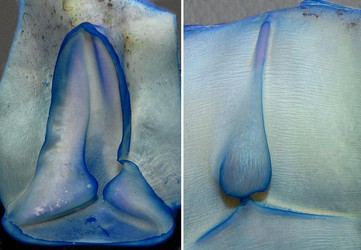
Ornithoteuthis antillarum. © Richard E. Young
- Photophores
- Three visceral photophores: Oval, anal photophore (right arrow below); posterior intestinal photophore (middle arrow below); posterior visceral strip photophore (left arrow below).
- One oval, ocular photophore on the ventral surface of each eyeball.
- Sexual dimorphism not clear. Some photophores may be more distinct in females (see Voss, 1957).
- Measurements and count (Voss, 1957)
Sex Male
Female
Mantle length 94
97
Mantle width 19 19.5 Head width 19 22.5 Fin length 49 52 Fin width 45 47 Length, arm I 41 33
arm II 49 43
arm III 51 43
arm IV 46 37.5
Tentacle length 79 78 Club length 29 26.5
- Folds in foveola and side pockets not always obvious (Voss, 1957).
Behavior
O. antillarum has been observed from submersibles feeding with its arms folded dorsally in a modified "J-posture" at a depth of 684m in the Bahamas: it can be recognized from submersibles by its long tail. A video of O. antillarum swimming can be seen here.

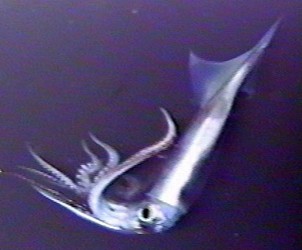
Figure. In-situ side view of O. antillarum in a J-posture. ©
Life History
Based on statolith increments representing daily growth lines, O. antillarum from the tropical central-east Atlantic (off the Gulf of Guinea) reach a maximum age of 182 days indicating a life span of about 6 months in both sexes (Arkhipkin, et al. 1998). Growth curves are sigmoidal with growth decreasing at the onset of maturation; this squid appears to be a multiple spawner frequently producing egg masses of less than 1500 eggs over a period of probably 1.5-3.0 months (Arkhipkin, et al. 1998).
Mean size of mature females was 100.39 mm ML (SD = 1.60) and 88.31 for mature males (SD = 1.73); maximum size of females captured was 138 mm ML and the largest male about 120 mm ML (Arkhipkin, et al. 1998). Ripe eggs are small, ranging from 0.73-0.8 mm in maximum diameter (Arkhipkin, et al. 1998).
Distribution
Type locality: Basse-Terre (Guadelope Island), Antilles, West Indies.
Reported from tropical and subtropical waters of the North Atlantic. In the western Atlantic it is known from about 40°N to 40°S, and in he eastern Atlantic from 20°N to 25°S (Dunning, 1988).
References
Arkhipkin, A. I., V. V. Laptikhovsky, Ch. M. Nigmatullin, A. V. Bespyatykh and S. A. Murzov. 1998. Growth, reproduction and feeding of the tropical squid Ornithoteuthis antillarum (Cephalopoda, Ommastrephidae) from the central-east Atlantic. Sci. Mar., 62: 273-288.
Dunning, M. C. 1998. A Review of the systematics, distribution, and biology of the arrow squid genera Ommastrephes Orbigny, 1835, Sthenoteuthis Verrill, 1880, and Ornithoteuthis Okada, 1927 (Cephalopoda: Ommastrephidae). Smiths. Contr. Zool., No. 586: 425-433.
Voss, G.L. 1957. Observations on Ornithoteuthis antillarum adam, 1957. An ommastrephid ssquid from the West Indies. Bulletin of Marine Science of the Gulf and Caribbean, 7(4):370-378.
Title Illustrations

| Scientific Name | Ornithoteuthis antillarum |
|---|---|
| Location | Region of Bahama Islands |
| Reference | Voss, G.L. 1956. A review of the Cephalopods of the Gulf of Mexico. Bulletin of Marine Science of the Gulf and Caribbean, 6(2):85-178, 18 figures. |
| Sex | Male |
| View | Dorsal |
| Size | 94 mm ML |
| Copyright | © Bulletin of Marine Science |
About This Page

National Museum of Natural History, Washington, D. C. , USA

University of Hawaii, Honolulu, HI, USA
Page copyright © 2015 and
 Page: Tree of Life
Ornithoteuthis antillarum .
Authored by
Michael Vecchione and Richard E. Young.
The TEXT of this page is licensed under the
Creative Commons Attribution-NonCommercial License - Version 3.0. Note that images and other media
featured on this page are each governed by their own license, and they may or may not be available
for reuse. Click on an image or a media link to access the media data window, which provides the
relevant licensing information. For the general terms and conditions of ToL material reuse and
redistribution, please see the Tree of Life Copyright
Policies.
Page: Tree of Life
Ornithoteuthis antillarum .
Authored by
Michael Vecchione and Richard E. Young.
The TEXT of this page is licensed under the
Creative Commons Attribution-NonCommercial License - Version 3.0. Note that images and other media
featured on this page are each governed by their own license, and they may or may not be available
for reuse. Click on an image or a media link to access the media data window, which provides the
relevant licensing information. For the general terms and conditions of ToL material reuse and
redistribution, please see the Tree of Life Copyright
Policies.
- First online 29 November 2009
- Content changed 26 February 2015
Citing this page:
Vecchione, Michael and Richard E. Young. 2015. Ornithoteuthis antillarum . Version 26 February 2015 (under construction). http://tolweb.org/Ornithoteuthis_antillarum/77433/2015.02.26 in The Tree of Life Web Project, http://tolweb.org/





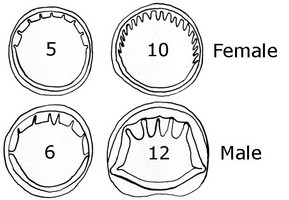



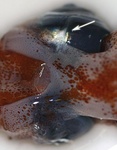



 Go to quick links
Go to quick search
Go to navigation for this section of the ToL site
Go to detailed links for the ToL site
Go to quick links
Go to quick search
Go to navigation for this section of the ToL site
Go to detailed links for the ToL site